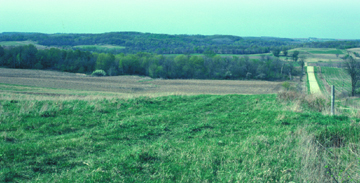 In 1942,
mappers doing reconnaissance work first noticed an anomalous geologic structure
in western Wisconsin. Now geologists have determined that the feature is a 430-
to 445-million-year-old meteorite impact structure.
In 1942,
mappers doing reconnaissance work first noticed an anomalous geologic structure
in western Wisconsin. Now geologists have determined that the feature is a 430-
to 445-million-year-old meteorite impact structure. Trees at the skyline mark the central uplift of a newly found impact structure in western Wisconsin. Elevation from the highest point of the crater to the lowest point is about 80 meters. Courtesy of Bevan French.
The 6.5-kilometer-wide circular structure has many of the tell-tale signs of extraterrestrial impact, according to geologists studying the site who published their findings in the January/February 2004 GSA Bulletin. The crater’s discovery is not only important to understanding the local geological picture, but also may have greater significance to the discovery of impact structures in sedimentary rocks around the world.
In 1985, William Cordua, a geologist at the University of Wisconsin-River Falls and co-author on the paper, first reported that the Rock Elm structure had the characteristics of a cryptoexplosion structure: a circular outline with intense localized deformation, a central uplift and the absence of intrusive igneous rocks or salt domes. He could not, however, tie the structure to an impact. In 1998, Bevan French, a geologist with the Smithsonian Institution and Cordua’s co-author, visited the site with a hunch that he would find diagnostic shock features in the central uplift.
“We found shocked quartz first,” French says, quartz grains that have unique microscopic deformation features caused by a significant pressure from an impact. Shocked quartz is the first thing geologists look for after identifying an anomalous circular structure, says Paul Heinrich, a geologist with the Louisiana Geological Survey. The quartz’s multiple sets of cleavage — breakage along planes, which quartz does not normally exhibit — were identical in texture to those found in established impact craters, French says. “This observation, combined with distinctive geological features, convinced us that Rock Elm was indeed an impact structure.”
At the surface, the deformed structure does not have an obvious topographic signature. It is deeply eroded and poorly exposed, with less than 100 meters of relief from highest point to lowest. But the circular structure has several components all indicative of an impact structure, such as a ring boundary fault, deformed blocks of sedimentary rocks and a central uplift of older rocks.
Working with French and Cordua, Jeff Plescia, a geologist with the U.S. Geological Survey and third author on the paper, recently completed further tests on the site to look for a gravity or magnetic anomaly in the area — both of which are distinct features of impact structures. However, he found no such anomalies associated with the Rock Elm structure.
“We were surprised,” French says, “but this is the case with a number of established impact structures, so we didn’t consider it as contrary evidence.” Heinrich agrees that the lack of these anomalies is not a problem and that the team’s other evidence is strong enough to support the impact hypothesis. Still, it would “be nice to do drilling or seismic work to see what the substructure at Rock Elm is really like and why it produces no anomaly,” French says.
Another question that arose was why the quartz exhibited slightly different characteristics from that found at other impact structures. French says that depending on the peak shock pressure, quartz can develop a wide range of structures, but he believes that any quartz grains that show multiple sets of cleavage likely indicate an impact. He hopes to spur further research into the potential use of varying quartz cleavage structures as tools to definitively identify impacts, and to learn more about the different conditions of impact that could produce such cleavage.
Hundreds of impact structures still remain to be discovered, French says, and he hopes his quartz research in Wisconsin will help identify those craters once they are discovered.

